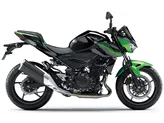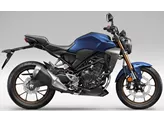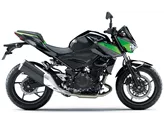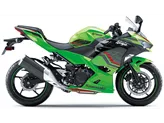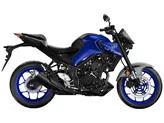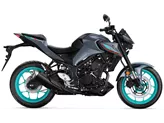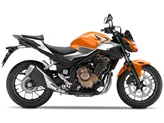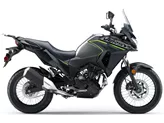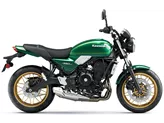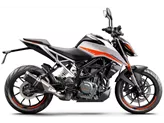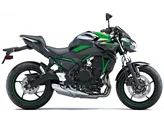Kawasaki Z 300 2015 vs. Kawasaki Z 400 2019

Kawasaki Z 300 2015

Kawasaki Z 400 2019
Visão geral - Kawasaki Z 300 2015 vs Kawasaki Z 400 2019
The Kawasaki Z 300 model year 2015 and the Kawasaki Z 400 model year 2019 are both naked bikes from Kawasaki, designed for street riding. While they share some similarities in terms of engine type, cooling system, and frame material, there are notable differences between the two models.
In terms of engine specifications, the Kawasaki Z 300 2015 is equipped with an inline twin-cylinder engine with a displacement of 296cc. It produces a power output of 39 horsepower and a torque of 27 Nm. On the other hand, the Kawasaki Z 400 2019 features a slightly larger inline twin-cylinder engine with a displacement of 399cc. It delivers a higher power output of 45 horsepower and a torque of 38 Nm. This means that the Z 400 has a more powerful engine, providing better acceleration and overall performance compared to the Z 300.
Both bikes have a liquid-cooled engine, which helps to maintain optimal operating temperatures and prevent overheating. This is beneficial for prolonged riding sessions and ensures consistent performance. Additionally, they both have a steel frame, providing a sturdy and durable chassis for stability and control.

Kawasaki Z 300 2015
In terms of braking, both models are equipped with dual-piston front brakes using petal technology. This ensures efficient and reliable stopping power. However, the Z 400 has a slightly wider rear tire (150mm) compared to the Z 300 (140mm), which may provide better traction and stability during braking and cornering.
In terms of dimensions and weight, the Z 300 has a larger wheelbase of 1405mm compared to the Z 400's 1370mm. This may affect the overall stability and maneuverability of the bikes. Both models have the same seat height of 785mm, ensuring a comfortable riding position for most riders. The Z 300 weighs 170kg (with ABS), while the Z 400 is slightly lighter at 167kg (with ABS).
One notable difference between the two models is the fuel tank capacity. The Z 300 has a larger fuel tank with a capacity of 17 liters, while the Z 400 has a smaller tank with a capacity of 14 liters. This means that the Z 300 may have a longer range before needing to refuel.

Kawasaki Z 400 2019
In terms of strengths, the Z 300 is praised for its mature appearance, high-quality finish, high-revving engine, comfortable seating position, stable braking, complete and easy-to-read cockpit, and low fuel consumption. On the other hand, the Z 400 is commended for its excellent and controllable power, reduced weight, good seating position, excellent sound, and suitability for beginner riders.
However, both models have their weaknesses. The Z 300 is criticized for its discreet sound, favorable chassis components, and the fact that the engine only starts in idle mode. The Z 400, on the other hand, has non-adjustable clutch and brake levers and limited chassis adjustability.
In conclusion, while the Kawasaki Z 300 2015 and the Kawasaki Z 400 2019 share some similarities, such as engine type, cooling system, and frame material, there are notable differences in terms of engine power, torque, rear tire width, wheelbase, fuel tank capacity, and weight. These differences contribute to variations in performance, handling, and overall riding experience between the two models.
Especificações técnicas Kawasaki Z 300 2015 em comparação com Kawasaki Z 400 2019
Prós e contras em comparação
Prós e contras em comparação
Kawasaki Z 300 2015

O design moderno da Kawasaki Z300, que é extremamente semelhante ao da sua irmã mais velha Z800, faz dela uma moto com um aspeto muito adulto. O sistema de travagem estável e o cockpit de fácil leitura com um conta-rotações analógico e todas as características necessárias enquadram-se muito bem nesta imagem. Graças aos 170 kg de peso pronto a conduzir, a moto é extremamente fácil de manusear e divertida. O motor só revela o seu potencial na gama superior de rotações, mas acelera com vontade e dá vontade de conduzir de forma desportiva. Apenas o chassis, orientado para o conforto, não consegue dar resposta às exigências radicalmente desportivas - mas isto é perfeitamente legítimo e compreensível para uma moto de entrada de gama.
Kawasaki Z 400 2019

A Kawasaki Z400 é definitivamente uma grande evolução da sua antecessora, a Z300. Mais potência, menos peso - em suma, simplesmente uma moto ainda melhor. Acima de tudo, a entrega de potência linear e o excelente manuseamento fazem da Z400 uma moto de entrada de gama ideal. A facilidade de operação da embraiagem e a boa configuração do quadro também estão nesta linha, razão pela qual a Z400 pode ser recomendada sem hesitação a pilotos principiantes.
Comparação de preços Preço médio de mercado Kawasaki Z 300 vs Kawasaki Z 400
There are a few key differences between a Kawasaki Z 300 2015 and a Kawasaki Z 400 2019. It takes less time to sell a Kawasaki Z 400 with 99 days compared to 111 days for the Kawasaki Z 300. Since model year 2015 1000PS.de editors have written 5 reviews for the Kawasaki Z 300 and 8 reviews for the Kawasaki Z 400 since model year 2019. The first review for the Kawasaki Z 300 was published on 04/11/2014 and now has more than 59.800 views. This compares to more than 23.200 views for the first review on Kawasaki Z 400 published on 02/10/2018.


